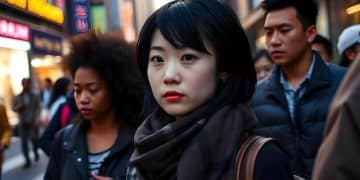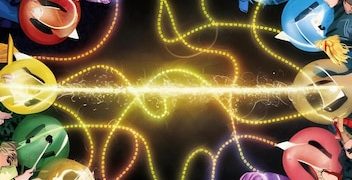Decoding J-Drama Tropes: 2025 Guide to Predict Plots & Arcs

Achieving mastery in decoding J-Drama tropes: A 2025 guide to predicting plot twists and character arcs involves recognizing recurring narrative patterns and character archetypes prevalent in Japanese television dramas, enabling viewers to anticipate story developments and enhance their overall viewing experience.
Ever found yourself halfway through a J-Drama, a nagging feeling telling you exactly how a convoluted misunderstanding will resolve, or which secondary character will suddenly reveal a hidden past? That’s the power of recognizing tropes. In 2025, with an ever-expanding library of captivating Japanese dramas, mastering the art of decoding J-Drama tropes: A 2025 guide to predicting plot twists and character arcs isn’t just about fun; it’s about elevating your viewing experience from passive consumption to an engaging analysis of storytelling brilliance.
The Enduring Appeal of J-Drama Tropes
J-Dramas, much like any long-standing narrative tradition, rely on a rich tapestry of recurring themes, character archetypes, and plot devices that resonate deeply with their audience. These recognizable elements, far from being a limitation, serve as a comforting framework, allowing viewers to invest emotionally and intellectually in the stories without needing to constantly re-learn narrative conventions. The allure lies in the way these tropes are reinterpreted and reimagined with each new series, offering both familiarity and a fresh perspective.
The year 2025 sees J-Dramas continuing their global expansion, captivating new audiences while retaining their distinctive charm. Understanding the DNA of these dramas—their core tropes—becomes crucial for anyone looking to truly appreciate their narrative craftsmanship. It’s akin to learning the grammar of a language; once you grasp the rules, you can appreciate the poetry.
The Comfort in Familiarity
There’s a unique satisfaction in anticipating a plot twist because you’ve seen a similar setup before, and then seeing how the drama either adheres to or subverts that expectation. This playful dance between predictability and surprise is a hallmark of good storytelling, and J-Dramas excel at it. The comfort of familiarity allows for deeper immersion, as viewers can focus less on “what happens next?” and more on “how will they get there?”
- Recognizable emotional beats build stronger connections.
- Shared cultural understanding through universal themes.
- The joy of seeing tropes executed with fresh perspective.
- Familiarity fosters a sense of community among fans.
In 2025, streaming platforms have made J-Dramas more accessible than ever, leading to a burgeoning global community of fans eager to discuss and dissect their favorite shows. Understanding common tropes empowers these discussions, allowing for nuanced analyses beyond simple plot summaries.
The evolution of J-Drama tropes reflects societal changes and evolving viewer tastes. What might have been a common trope a decade ago could now be subtly challenged or reframed to better suit contemporary relevance. This dynamic nature keeps the genre vibrant and endlessly fascinating.
Classic Character Archetypes and Their Predictable Paths
Character archetypes are the backbone of many stories, and J-Dramas are no exception. From the stoic hero to the quirky best friend, these recurring figures often follow predictable arcs, allowing savvy viewers to foresee their emotional journeys and contributions to the plot. Recognizing these archetypes early on can be a key part of decoding J-Drama tropes.
Consider the “Tsundere” character – outwardly cold or abrasive, but secretly caring. Their inevitable softening towards the protagonist is a well-loved pathway. Or the “Genius with a Social Awkwardness” archetype, whose brilliance often comes hand-in-hand with hilarious or heartfelt social blunders. Their journey typically involves learning the value of human connection beyond pure intellect.
The “Unlikely Pair” Romance
This staple involves two characters who, on the surface, seem entirely mismatched but are fated to fall in love. Often, one is boisterous and outgoing, the other reserved and cynical. Their initial friction invariably sparks undeniable chemistry. This trope rarely disappoints, as the audience knows from the outset that their contrasting personalities will eventually complement each other beautifully.
- Odd couples bring comedic and dramatic tension.
- Character growth often stems from learning from their opposite.
- Anticipated romantic development builds viewer investment.
Another popular archetype is the “Workaholic who prioritizes career over personal life.” Their arc almost always involves a pivotal event or relationship that forces them to re-evaluate their priorities, leading to a more balanced and fulfilling existence. These characters provide an aspirational element, reflecting the struggles many face in modern society.
Understanding these archetypes isn’t about criticizing a lack of originality, but appreciating the skilled variations writers employ. A good J-Drama will take a classic archetype and infuse it with unique quirks or challenging circumstances, making the predictable path feel fresh and earned.

Plot Devices and Narrative Structures: Reading Between the Lines
Beyond characters, J-Dramas frequently employ specific plot devices and narrative structures that become signposts for upcoming twists. These can range from the classic “misunderstanding” that drives a significant portion of the plot to the “fated encounter” that sets the entire story in motion. Learning to identify these allows for more informed predictions of narrative turns.
The “Time Limit” trope is a prime example. Whether it’s a character with a limited lifespan, a project with a strict deadline, or a temporary living arrangement, this device immediately introduces urgency and often dictates emotional intensification and expedited relationship development. The audience knows that whatever resolution is coming, it will be under pressure.
The Inevitable Confession and Its Aftermath
A cornerstone of romance J-Dramas is the often-delayed, deeply emotional confession of feelings. The buildup can be agonizingly slow, filled with missed opportunities and near-confessions. Once it happens, observant viewers know that the next phase of the relationship—whether triumphant or fraught with new challenges—is about to begin. The “aftermath” often involves navigating societal expectations, family disapproval, or personal insecurities.
- Confessions mark a critical turning point in romantic plots.
- The delay builds tension and emotional resonance.
- Post-confession developments offer new narrative directions.
Another common narrative structure is the “Problem of the Week” in procedural or educational dramas. While there might be an overarching season-long mystery or character arc, many episodes feature a self-contained conflict that is introduced, explored, and resolved within that single episode. This structure provides satisfying conclusions to immediate dilemmas while slowly building towards larger revelations. In 2025, this format remains popular for its accessibility.
The “Memory Loss” trope, while often criticized, is skillfully utilized in many J-Dramas to explore themes of identity, connection, and the weight of the past. When a character loses their memory, viewers can anticipate a journey of rediscovery, often aided by those closest to them, leading to a poignant re-evaluation of their relationships.
Cultural Nuances and Their Impact on Storytelling
J-Drama tropes are not isolated incidents; they are deeply interwoven with Japanese cultural values, societal norms, and historical context. Understanding these nuances is paramount to truly appreciate and predict the narrative flow. Elements like “Gaman” (endurance and self-restraint), “Wa” (harmony), and the importance of “Senpai-Kohai” (senior-junior) relationships frequently shape character motivations and plot resolutions.
The concept of “fate” or “destiny” is often a strong undercurrent in J-Dramas, particularly in romantic and fantasy genres. Characters frequently grapple with pre-ordained circumstances, leading to dramatic conflicts and resolutions that often emphasize acceptance or the power of collective will.
The “Duty vs. Desire” Conflict
A pervasive theme is the internal struggle between personal desires and societal or familial obligations. This often manifests in characters choosing a path of self-sacrifice for the greater good of their family, company, or community. This deeply ingrained cultural value often dictates critical character decisions and plot trajectories, making it a powerful predictive tool for viewers.
- Cultural values drive character choices and conflicts.
- Sacrifice for others highlights communal harmony.
- Predictable outcome often aligns with duty over individual happiness.
The emphasis on “effort” and “hard work” is another cultural cornerstone reflected in J-Dramas. Protagonists often face monumental challenges, but through sheer perseverance and dedication, they achieve their goals. This trope is particularly common in sports dramas, inspirational stories, and coming-of-age narratives. Viewers can reliably predict that a character’s hard work will eventually bear fruit, even against seemingly insurmountable odds.
The subtle ways characters communicate non-verbally, often driven by a desire to maintain “Wa” or avoid direct confrontation, can also be a unique aspect of J-Drama storytelling. Misunderstandings can easily arise from these indirect communication styles, creating dramatic tension that is uniquely Japanese in its execution. Predicting how these unspoken feelings will eventually surface is a key part of the viewing enjoyment.
Subverting Expectations: When Tropes Take a Turn
While many tropes provide a comforting sense of predictability, the true genius of J-Dramas often lies in their ability to subvert these very expectations. In 2025, as global audiences become more sophisticated, writers are increasingly playing with established tropes to deliver surprising and impactful narratives. Recognizing when a drama is intentionally steering away from the familiar path is a skill that enhances the viewing experience exponentially.
The “Redemption Arc” is a classic. A morally ambiguous character commits wrongdoings, then embarks on a journey of atonement. However, a subverted version might show a character failing to fully redeem themselves, or even choosing a path of continued moral ambiguity, challenging the audience’s desire for a neat, heroic resolution.
The Unexpected Villain Reveal
The “seemingly trustworthy mentor figure” who turns out to be the true antagonist is a trope that can be deliciously subverted. Instead of the typical grand reveal, some dramas might make the villainy more ambiguous, perhaps presenting a character who believes their actions are justified, or whose motivations are more complex than pure evil. This creates a morally gray area that is far more compelling than a clear-cut good vs. evil scenario.
- Challenges preconceived notions of good and evil.
- Adds layers of complexity to character motivations.
- Generates genuine surprise and deepens narrative impact.
Another popular subversion involves the “Love Triangle.” Instead of the expected outcome of the protagonist choosing one suitor over the other, some J-Dramas might present a resolution where neither pairing occurs, or where the characters decide to prioritize self-growth or a platonic relationship. This defies the conventional romantic ending, offering a more realistic reflection of human connections.
The “Underdog Hero” is a beloved trope. They overcome immense obstacles through sheer grit. But a subversion might involve the underdog not winning in the conventional sense, but finding victory in a different, more personal way, or even facing a poignant defeat that offers a deeper philosophical message. These unexpected turns challenge viewers to think beyond traditional triumphant narratives.

The Role of Meta-Commentary and Self-Awareness in Modern J-Dramas
As the landscape of entertainment evolves, so does the sophistication of J-Drama storytelling. In 2025, many series exhibit a self-awareness, often engaging in meta-commentary about their own genre and its tropes. This can involve characters directly referencing common drama plots, or the narrative intentionally playing with viewer expectations based on popular conventions. This meta-layer adds another dimension to decoding J-Drama tropes.
Some dramas might present a stereotypical character type, only to have other characters in the show point out the “clichéd” nature of their behavior, effectively winking at the audience. This kind of self-referential humor not only entertains but also deepens the appreciation for the writers’ understanding of their craft and their audience.
Breaking the Fourth Wall for Deeper Engagement
While not strictly breaking the fourth wall in a direct address to the audience, modern J-Dramas often create scenarios where the characters or narration comment on storytelling conventions. This subtle meta-commentary invites viewers to become more active participants in the decoding process, challenging them to think about why certain narrative choices are being made.
- Engages viewers in a more intellectual way.
- Highlights the craftsmanship of the writing.
- Adds layers of humor and irony to the narrative.
The discussion around “J-Drama tropes” itself has become a topic within certain series, particularly those of a more comedic or slice-of-life nature. Characters might express frustration with typical romantic comedy scenarios or comment on the predictability of a detective show within their own fictional world. This creates a delightful feedback loop where the drama acknowledges its own genre conventions.
In 2025, with the proliferation of fan theories and online discussions, J-Drama creators are more attuned than ever to audience expectations regarding tropes. This has led to a fascinating interplay where dramas might lean into a trope heavily, knowing the audience anticipates a certain outcome, only to then completely flip it, providing a satisfying surprise that only works because of the shared understanding of the convention.
Predicting Character Arcs: Beyond Surface-Level Traits
Predicting character arcs involves looking beyond initial impressions and surface-level traits to understand the underlying motivations, fears, and desires that drive a character’s journey. In J-Dramas, these arcs are often meticulously planned, even if they appear subtle at first glance. By analyzing early interactions, internal monologues, and subtle visual cues, viewers can often chart a character’s likely development.
Consider the quiet, unassuming character who rarely speaks up. In a J-Drama, it’s highly probable that this character will eventually find their voice, often through a pivotal event or the influence of another character. Their arc is usually one of self-discovery and empowerment, culminating in a confident assertion of their true self.
The Transformation of the Antagonist
While some villains remain unequivocally evil, a compelling J-Drama often provides a more nuanced antagonist whose arc involves a complex transformation, or at least a deeper understanding of their motivations. This doesn’t always lead to redemption but can result in a more sympathetic portrayal or a tragic realization, adding significant depth to the narrative.
- Antagonists offer opportunities for moral exploration.
- Complex villains create more engaging conflicts.
- Transformation can be internal, not just external actions.
Another common character arc is the “Protagonist who initially lacks a clear direction or purpose.” Their journey often involves exploring various paths, failing, learning from mistakes, and eventually discovering a passion or a calling that gives their life meaning. These arcs are particularly resonant as they mirror the real-life struggles of finding one’s place in the world.
Predicting arc also involves paying attention to recurring symbols or metaphors associated with a character. A character constantly associated with a wilting plant might be on a path to renewal, while one who always wears muted colors might eventually embrace vibrancy as they grow. These visual cues are often deliberate hints at their internal journey and future development, making the act of decoding J-Drama tropes a rich, multi-sensory experience.
| Key Aspect | Brief Description |
|---|---|
| 🎭 Character Archetypes | Recurring character types like Tsundere, workaholic, or unlikely partners, often following predictable developmental paths. |
| 📖 Narrative Devices | Common plot tools such as time limits, misunderstandings, or fated encounters, used to propel story forward. |
| 🌸 Cultural Influences | Japanese values like Gaman or Wa deeply shape character choices and narrative resolutions in J-Dramas. |
| 🔄 Trope Subversion | Modern J-Dramas intentionally twist classic tropes to surprise and engage, challenging viewer expectations. |
Frequently Asked Questions About J-Drama Tropes
J-Drama tropes, like any narrative convention, provide a shorthand for storytelling. They’re deeply embedded in Japanese cultural values, allowing writers to tap into shared societal understandings and emotional frameworks without extensive exposition, making them effective and relatable across various genres, from romance to mystery.
Understanding tropes transforms passive viewing into active analysis. It allows you to anticipate plot twists, appreciate how a drama plays with or subverts expectations, and delve deeper into cultural nuances, leading to a richer and more satisfying engagement with the narrative and characters.
While many J-Drama tropes have universal themes (e.g., love, loss, courage), their specific manifestations are often deeply rooted in Japanese cultural values, social dynamics, and historical context. This provides a unique blend, making them both broadly relatable and distinctly Japanese.
Not necessarily. Instead of spoiling, recognizing tropes often enhances enjoyment by allowing you to appreciate the writer’s skill in executing familiar patterns or, conversely, in cleverly subverting them. It turns viewing into a more intellectual and interactive process, seeing the artistry behind the narrative choices.
In 2025, J-Drama tropes often feature more meta-commentary, self-aware narratives, and innovative subversions. There’s a noticeable trend towards challenging traditional gender roles, exploring mental health with greater nuance, and incorporating diverse narratives, reflecting a more globalized and socially conscious storytelling approach.
The Art of Anticipation: Mastering J-Drama Narratives
Ultimately, the journey of decoding J-Drama tropes: A 2025 guide to predicting plot twists and character arcs is an enriching one, transforming casual viewers into astute observers of narrative artistry. It’s about recognizing the familiar patterns that comfort and engage us, understanding the cultural threads that weave these stories, and delighting in the clever ways writers subvert expectations. As J-Dramas continue to evolve and captivate a global audience, the ability to anticipate and analyze their structural underpinnings becomes an increasingly valuable tool, deepening appreciation and fostering a more profound connection with these remarkable narratives. It moves beyond simply watching a story unfold, inviting us to partake in the intricate dance of creation and expectation, making every episode a masterclass in cinematic anticipation.





